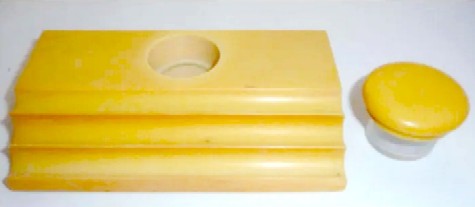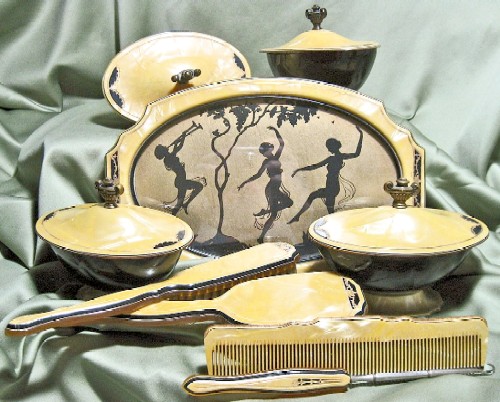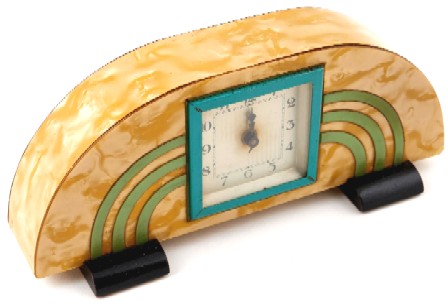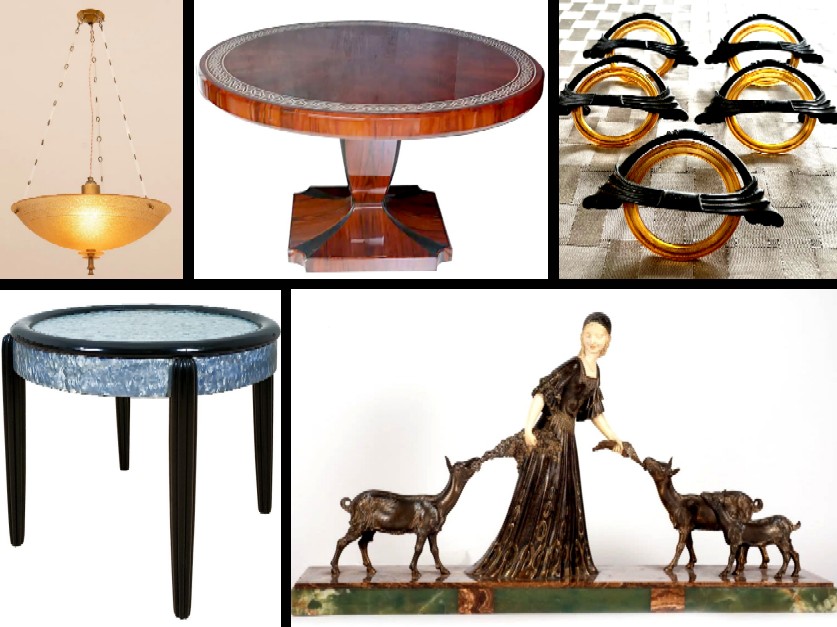
Material - Celluloid
Celluloid has a variety of uses and is probably best known as the material used for producing film up until the 1950s. However,

Natural Celuloid Inkwell, Marked 'Ivoree' on Bottom, c. 1930, Ruby Lane
it had a role in industrial design during the Art Deco and Streamline Moderne periods. It was used in small household items primarily as an inexpensive substitute for ivory and is found in furniture hardware, statues, clocks and even lighting. It was marketed for these uses as Ivarine, Ivaleur, French Ivory, Parisian Ivory, grained ivory and Ivory Pyralin.
Celluloid was first recognized as a medium for making objects by Alexander Parkes in 1855. He noticed that during the production of Collodion, a substance used as an emulsion for photographic plates, a solid residue was left behind. He patented the substance in 1862 as a waterproofing material for cloth. Parkes created Parkesine - considered to be the first plastic - by treating cellulose with nitric acid and a solvent. Unfortunately, due to financing problems, he went out of business in 1868.
Around this time, John Wesley Hyatt bought Parke's patent, looking to create billiard balls with Parkesine as a cheaper alternative to the ivory

Celluloid Vanity Set with Brushes, Button Hook, Comb and Assorted Containers, 1920s
Marked as 'Pryalin' by the Dupont Company, Etsy
billiard balls which were then in use. By adding camphor to Parkesine, he created a 'horn-like' material. The camphor increased the plasticity of Parkesine, making it softer and more flexible. Hyatt's brother Isaiah called the resulting material celluloid. They created the Albany Dental Plate Company to produce products with the new material, eventually renaming it the Celluloid Manufacturing Company.
In 1883, a French company discovered a way to add grain lines to celluloid, giving it the appearance of ivory. This is why it is sometimes called grained, French and Parisian Ivory, giving it the sound of a high-end material. Products which would have previously been made of more expensive materials like ivory and horn such as jewellery, jewellry boxes, dressing table sets and hair accessories often used this type of grained celluloid.
The 'natural' color of celluloid pieces is pale yellow, although it can take a variety of forms and colors. Because it was easy to work and durable when new, it was frequently used as a replacement for ivory, which was three times as expensive and weighed more. Like its cousin Bakelite, Celluloid pieces were sometimes used as decorative additions to furniture pulls and handles or even as the handles themselves. It was also used to created the 'skin' on a variety of statues made during the 1920s and 1930s. Some antique sellers state that period plastic products are 'cellulose' or 'nitrocellulose', but something must be added to nitrocellose plasticize it. This is how Parkesine or what is today called celluloid is made. However, cellulose can be reacted with alcohol and acids to create paint with a bright appearance.

Clock with Nitrocellulose Casing & Wooden Feet, 1930s, Science Museum Group
Cellulose could be colored, although, even with the addition of colorants they tended to retain some of their transluscence. Some of the colors included an amber swirls which produced a tortoiseshell appearance (see the sconce lamps above right), black, white, pink, green, yellow and a pastel blue.
Shelf clocks and furniture items were sometimes covered with celluloid in a manner similar to the way wood veneer was applied to the less expensive wood base of furniture. For such uses, the celluloid was printed to look like expensive wood, marble or granite. The Seth Thomas clock company purchased rights for its use from the Celluloid Manufacturing Company in 1880 for this use, marketing it as a coating called Adamantine.
Unfortunately, celluloid is very flammable and is even known to self-ignite at temperatures of 302 degrees Fahrenheit (150 degrees Celsius). This, added to the fact that it was more expensive to produce than Bakelite and Catalin led to the decline in its use. Despite this, a type of celluloid is still being manufactured today and used in small items like pens and guitar picks. However, today's celluloid is cellulose acetate which looks and feels different from what was in use during the Art Deco and Streamline Moderne periods.
Sources Not Cited Above:
Pamela Wiggins, "What You Need to Know About Celluloid", the Spruce Crafts, gathered 4-28-24
"Celluloid", Wikipedia.com, gathered 4-28-24
"Albany Billiard Ball Company", Wikipedia.com, gathered 4-28-24
"John Wesley Hyatt", Wikipedia.com, gathered 4-28-24
Diana, "What is Celluloid?", airondackgirlatheart.com, gathered 2-12-25
David Nishimura, "What is celluloid?", Vintage Pens website, gathered 2-12-25
"Cellulose Paints", Hemel website, gathered 2-12-25
Original Facebook Group Posting
 Celluloid Use, from left - Celluloid Chandelier, British, c. 1930, The Old Cinema; Rosewood Veneer Table with Serpentine Celluloid Inlaid Border, 1930s, 1st Dibs, Brass Drawer Pull with Celluloid Ring, From Vanity, 1930s - 40a, eBay; Side Table, Stained and Varnished Beech with Blue Celluloid Top and Surround, French, c. 1925, 1st Dibs; Girl with Goats Statue, Marble and Onyx Plinth, Spelter Statues, Celluloid Face and Hands, Demetre Chiparus, Drouot.
Celluloid Use, from left - Celluloid Chandelier, British, c. 1930, The Old Cinema; Rosewood Veneer Table with Serpentine Celluloid Inlaid Border, 1930s, 1st Dibs, Brass Drawer Pull with Celluloid Ring, From Vanity, 1930s - 40a, eBay; Side Table, Stained and Varnished Beech with Blue Celluloid Top and Surround, French, c. 1925, 1st Dibs; Girl with Goats Statue, Marble and Onyx Plinth, Spelter Statues, Celluloid Face and Hands, Demetre Chiparus, Drouot.